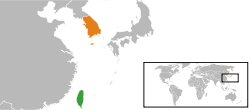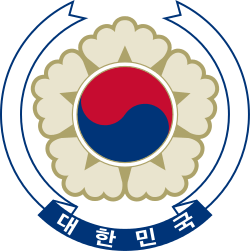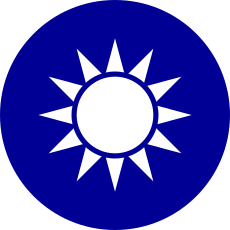South Korea–Taiwan relations
 |
|
Taiwan |
South Korea |
|---|---|
| Diplomatic Mission | |
| Taipei Mission in Korea | Korean Mission in Taipei |
The Republic of China government recognized the formation of the Provisional Government of the Republic of Korea on April 13, 1919, as one of the participants of the Cairo Conference, which resulted in the Cairo Declaration. One of the main purposes of the Cairo Declaration was to create an independent Korea, free from Japanese colonial rule.[1] Bilateral diplomatic relations between the Government of Republic of Korea and the Republic of China began in 1948, just after the foundation of the First Republic.
Diplomatic relations between South Korea and Taiwan were terminated on 23 August 1992, followed by South Korean recognition of the People's Republic of China (PRC) and formation of bilateral recognition between them. Both countries still maintain non-diplomatic relations.
Independence of the Republic of Korea and the Korean War
The division of Korea was followed by a period of trusteeship by American occupation in the south. The first General Election of South Korean Constitutional Assembly election, 1948 founded the First Republic under the supervision of United Nations. The Republic of China recognized the Constitutional Korean government in the southern portion of the Korean Peninsula and opened an Embassy in Myeongdong, Seoul, on 4 January 1949, four months after the establishment of the Republic of Korea.
The People's Republic of China (PRC) was founded in 1949 following the Chinese Civil War and Republic of Korea maintained relations with the Republic of China (ROC), which relocated to Taiwan. The United Nations condemned North Korea's military aggression against Republic of Korea in United Nations Security Council Resolution 82 and United Nations Security Council Resolution 84. The ROC voted in favor of both United Nations resolutions. During the Korean War, the Taiwan supplied material aid to ROK,[2] while the People's Republic of China gave North Korea combatants to support the People's Volunteer Army.
Cold War diplomacy
Both South Korea and Taiwan were countries against communism, and in opposition to the People's Republic of China (PRC). Neither South Korea nor Taiwan recognized or formed a diplomatic relationship with the PRC government. Republic of Koreans referred to the PRC as 'Communist China'(중공, 中共), and the ROC as 'Nationalist China' (국부중국, 國府中國; before 1960s) or 'Free China' (자유중국, 自由中國; after 1970s). Taiwan also considered the Republic of Korea government as the sole legitimate state in the Korean peninsula.
President Park Chung-hee visited Taipei on a state visit in February 1966, in which he expressed solidarity with the ROC and South Vietnam, declaring that: 'We are not breakwaters which passively protect the port from onrushing waves. We are not standing still only to be gradually eroded by the waves of Communism.'[3]
Termination of diplomatic relations
The Sixth Republic of South Korea furthered the Miracle on the Han River to the Economy of South Korea and opened diplomacy to Communist Nations (including building the foundation of Inter-Korean relations [4] and accepting co-existence with North Korea by entering the United Nations as South Korea). Seoul also hosted the 1988 Summer Olympics. President Roh Tae-woo's next political ambition was to begin implementing Realpolitik with the neighboring countries in Northeast Asia.
On 23 August 1992, South Korea opened diplomatic relations with China.[5] South Korea's movement away from anti-communist foreign policy to improve relations with nearby communist countries resulted in a deterioration of relations with Taiwan. This change was introduced to appease North Korea and ease the political anxiety and softens military tension in the Korean Peninsula; Korea hoped to enable the possibility of a peaceful reunification in the Korean peninsula. As normalization began, ROK transferred diplomatic recognition from Taiwan to the PRC, and confiscated the property of the Taiwanese embassy, transferring it to the PRC.[6] On 17 September 1991, the PRC withdrew its objection to South Korean membership in the United Nations.[7] Republic of Korea was the last Asian country with formal diplomatic relations with Taiwan.
Economy
The annual trade volume between South Korea and Taiwan is around US$30 billion, with semiconductor products have been the largest item in the trade over the past few years. As of April 2016, the total amount of mutual investments between the two sides reached around US$2.4 billion in areas such as communication, consumer products, finance, information technology, iron, medicine, metal, securities and semiconductor.[8]
Flights between South Korea and Taiwan
After Seoul's recognition of the PRC government in Beijing, direct commercial flights between Seoul and Taipei operated by Korean and Taiwanese airlines were terminated. Cathay Pacific and Thai Airways International however, operated the route as a Fifth Freedom sector. The reduction of scheduled flights caused tourist numbers from Taiwan to drop from 420,000 in 1992 to 200,000 in 1993, recovering only partially to 360,000 by 2003.[9]
On September 1, 2004, representatives of the two countries' unofficial missions, the "Korean Mission in Taipei" and the "Taipei Mission in Seoul" signed an aviation agreement allowing aircraft of each side to enter the airspace of the other. This permitted the resumption of direct scheduled flights by Korean and Taiwanese airlines and also allowed flights from Republic of Korea to Southeast Asia to fly over the island of Taiwan instead of detouring over mainland China or the Philippines. Analysts estimated this would save Republic of Korean airline companies ₩33 billion (US$29 million at 2004 exchange rates) in fuel costs and other fees.[10]
Kim Young-sam's visits to Taiwan
Former President of Republic of Korea Kim Young-sam visited Taipei for five days in July 2001. During this visit, he met President of the Republic of China Chen Shui-Bian at a lunch banquet, but the two were unable to come to an agreement over the wording of a joint written statement urging the resumption of direct air travel. Kim informed the embassy of the People's Republic of China in advance of his visit.[11]
In October 2004, following the aviation agreement, Kim came to Taiwan once more at Chen's invitation. He delivered a speech at National Chengchi University and toured port facilities in Kaohsiung, the sister city of Republic of Korea's Busan.[12]
Chinese Taipei admission into APEC
The ROK government acted as the interlocutor [13][14][15][16][17] and supported Taipei's admission into Asia-Pacific Economic Cooperation (APEC) in 1991 as a Chinese economy. Republic of Korea altered the nature of political acronym of Member States to Member Economies in APEC to make APEC formally a Trans-Pacific Economic Forum. Personnel of Taipei's Ministry of Foreign Affairs are forbidden to participate in the APEC, but the Minister of Economic Affairs of Republic of China, a special envoy appointed by the President of Republic of China and business representatives from Republic of China that publicly, can attend annual APEC Meetings under the name of Chinese Taipei.[18][19][20] Taipei can also host non-ministerial APEC consortiums and workshops concerning topics in which Chinese Taipei has specific strengths, such as technology and small and medium enterprise. These consortia and workshops are intended to address only success on economics and business-related issues with other APEC Member Economies. Chinese Taipei's participation in APEC is supported by the United States and accepted by People's Republic of China. The APEC Business Travel Card (ATBC) scheme applies to business travelers to and from Chinese Taipei.[21]
Re-establishing non-official relations
Republic of Korea re-established non-official relations with Republic of China in 1993, interchangeably and reciprocally as Korean Mission in Taipei and Taipei Mission in Korea.[22][23] Taipei Mission in Korea, Busan Office is located in the southern region of ROK.[24] Since 1993, there is significant trade volume between the two nations.[25][26][27] Two countries have mutually extended to 90 days of stay with the exemption of visa for visitors from July 1, 2012.[28] The 19th Seoul-Taipei forum was held on October 13, 2010.[29][30][31]
ROC nationals in ROK
Since China and South Korea established diplomatic ties in 1992, strong Chinese political and economic influences enabled the South Korean government to relax financial and political impediment to Chinese nationals in South Korea since 1970's, but 99% hold Republic of China (Taiwan) passports, including those naturalized as Korean citizens, or permanent residents, entry/re-entry permit, and rights of universal suffrage.[32][33]
Education
There are multiple ROC Chinese international schools in Republic of Korea:
- Seoul Chinese Primary School
- Seoul Overseas Chinese High School
- Yeongdeugpou Korea Chinese Primary School
- Overseas Chinese Elementary School Busan
- Overseas Chinese Middle and High School Busan
- Overseas Chinese Elementary School Daegu
- Overseas Chinese Middle and High School Daegu
- Overseas Chinese School Incheon
- Suwon Zhongzheng Chinese Elementary School
- Overseas Chinese Elementary School Uijongbu
- Wonju Chinese Elementary School
- Chungju Chinese Elementary School
- Onyang Chinese Elementary School
- Kunsan Chinese Elementary School
There are two South Korean international schools in the ROC:
- Taipei Korean Elementary School (타이뻬이한국학교)
- Kaohsiung Korea School (까오숑한국국제학교)
See also
References
- ↑ "The Avalon Project : CAIRO CONFERENCE 1943". Retrieved 3 April 2016.
- ↑ "The 60th Anniversary of the Korean War: UN Allies".
International organizations as well as the UN member nations, such as Brazil, Taiwan, Cuba, Ecuador, Iceland, Lebanon, Liberia, Mexico, Nicaragua, Pakistan, Paraguay, Peru, Uruguay and Venezuela, helped Korea with materials support.
- ↑ The Month in Free China, Taiwan Review, March 1, 1966
- ↑ Lee Hu Rak; Kim Young Ju (July 4, 1972). "July 4th North-South Joint Statement". Retrieved 13 May 2012.
- ↑ China and South Korea Planning To Establish Diplomatic Relations, New York Times, August 23, 1992
- ↑ ROC condemns flag ultimatum, Taiwan Journal, January 12, 1993
- ↑ Korea, a Century of Change, Jürgen Kleiner, World Scientific, 2001, page 341
- ↑ http://www.chinapost.com.tw/taiwan/arts-leisure/2016/09/28/479534/Korea-and.htm
- ↑ Navigating through the Sea of Westphalia Diplomacy: Role of Think Tank in Taipei-Seoul Forum, Hwei-luan Poong, Institute of International Relations, National Chengchi University, page 24
- ↑ Petty, Andrew (2004-09-15). "Korea-Taiwan flying close to the wind". Asia Times Online. Retrieved 2008-02-05.
- ↑ "Confusion surrounds S. Korean visit". Taipei Times. 2001-07-28. Retrieved 2008-02-05.
- ↑ "Kim Young-sam goes on a stroll through Kaohsiung". Taipei Times. 2004-10-30. Retrieved 2008-02-05.
- ↑ "中小企業財會資訊服務網". Retrieved 3 April 2016.
- ↑ http://www.mofa.gov.tw/PDA/News/Detail/597a4c45-f5db-4787-9554-5804b1b91030?arfid=88ce0e14-af13-4a76-8015-83fe91b55db0
- ↑ "apec-paper-2". Retrieved 3 April 2016.
- ↑ "臺灣記憶 Taiwan Memory--國家圖書館". Retrieved 3 April 2016.
- ↑ "亞太經合組織". Retrieved 3 April 2016.
- ↑ Chen Hsi Fan(陳錫蕃); He Zhi Yong(何志勇) (21 November 2011). "廿年前我國加入APEC的經緯" [Details of Chinese Taipei's entry to APEC]. National Policy Foundation (in Chinese). Retrieved 13 May 2012.
- ↑ Wu Lin-jun(吳玲君) (8 October 2001). "台灣在APEC中現有的角色及未來的調整" [Chinese Taipei's role in APEC: Now and future]. National Policy Foundation (in Chinese). Retrieved 13 May 2012.
- ↑ "Foundation and continuum of APEC". Chinese Taipei APEC study center (in Chinese).
- ↑ "APEC Business Travel Card: Benefits for cardholders". Retrieved 13 May 2012.
- ↑ http://taiwan.mofat.go.kr/languages/as/taiwan/news/notice/index.jsp
- ↑ Internet Team. "首頁 - Taipei Mission in Korea 駐韓國台北代表部". Retrieved 3 April 2016.
- ↑ "Bureau of Consular Affairs, Ministry of Foreign Affairs - Korea-Busan". Retrieved 3 April 2016.
- ↑ Ministry of Foreign Affairs, Republic of Korea. "駐台北韓國代表部". Retrieved 3 April 2016.
- ↑ Ministry of Foreign Affairs, Republic of Korea. "Ministry of Foreign Affairs, Republic of Korea-Bilateral Economic Relations". Ministry of Foreign Affairs, Republic of Korea. Retrieved 3 April 2016.
- ↑ http://taiwantoday.tw/ct.asp?xItem=176201&CtNode=428
- ↑ http://www.taiwanembassy.org/KR/ct.asp?xItem=289990&ctNode=1486&mp=206
- ↑ "Welcome to Seoul Forum website". Retrieved 3 April 2016.
- ↑ http://www.seoulforum.or.kr/english/images/affairs.pdf
- ↑ "Welcome to Seoul Forum website". Retrieved 3 April 2016.
- ↑ http://big5.southcn.com/gate/big5/gocn.southcn.com/qw2index/2006dzkwlsfbq/200610100007.htm
- ↑ http://www.ocac.gov.tw/OCAC/SubSites/Pages/VDetail.aspx?site=70f1a98b-5419-4d3d-bbb4-42860d1224dc&nodeid=1141&pid=6914
Further reading
Hu, S. “The Korean Factor in Cross-Taiwan Strait Relations,” in Baogang Guo and Chung-chian Teng, ed., China’s Quiet Rise: Peace through Integration (New York: Lexington Books, 2011): 103-123.
Giovannettone, J. “Chain Reactions: Linking the Conflicts on the Korean Peninsula and Taiwan Strait,” American Diplomacy (November 2006): 1-19.

